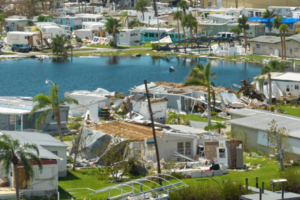Welcome to the enchanting landscapes of Southwest Florida, a region blessed with coastal charm and vibrant beauty. However, amid the allure lies a formidable challenge – the annual threat of hurricanes and tropical storms. Protecting your home against these powerful forces requires not only awareness but also strategic choices in roofing materials and construction techniques. In this in-depth guide, we will explore the intricacies of hurricane-resistant roofing, offering insights into the best materials and construction methods to fortify your Southwest Florida home against the unpredictable storms that grace this coastal paradise.
Understanding the Southwest Florida Weather Challenge
Before we delve into the specifics of hurricane-resistant roofing, it’s crucial to comprehend the unique weather challenges that Southwest Florida faces.
1. High Winds:
Hurricanes and tropical storms bring with them powerful winds capable of exerting tremendous force on your home’s roof. Opting for materials and construction methods that can withstand these winds is of utmost importance.
2. Heavy Rainfall:
These storms often unleash torrential rains, posing a potential risk of water damage. A robust roofing system must efficiently channel and repel rainwater to prevent leaks and structural issues.
3. Debris Impact:
Flying debris during storms is a significant threat to roofs. The chosen roofing materials should be resilient enough to withstand impacts and safeguard the structural integrity of your home.

Hurricane-Resistant Roofing Materials
1. Metal Roofing:
Renowned for its exceptional durability and resistance to high winds, metal roofing stands as a top choice for hurricane-prone regions. Materials like aluminum and steel, known for their corrosion resistance, provide long-lasting protection.
2. Concrete Tiles:
Concrete tiles, prized for their strength and durability, offer excellent resistance to high winds and impacts. Additionally, they provide an added layer of insulation, contributing to the energy efficiency of your home.
3. Clay Tiles:
Similar to concrete tiles, clay tiles are celebrated for their sturdiness and ability to endure harsh weather conditions. Resistant to high winds, they offer an aesthetically pleasing option for homeowners seeking a timeless look.
4. Asphalt Shingles with High Wind Ratings:
For those who prefer the versatility and cost-effectiveness of asphalt shingles, choosing those with high wind ratings is imperative. Seek out shingles that have been tested and rated for hurricane-force winds.
5. Synthetic Roofing Materials:
Advancements in synthetic roofing materials have introduced options that mimic the appearance of traditional materials like wood or slate while offering superior durability and resistance to the elements.
Construction Techniques for Maximum Protection
1. Roof Deck Attachment:
Ensuring a secure attachment of the roof deck to the underlying structure is fundamental. This involves the use of appropriate fasteners and adhesive techniques to prevent the roof from lifting during high winds.
2. Impact-Resistant Underlayment:
The installation of impact-resistant underlayment provides an extra layer of protection against water infiltration and damage from debris impact. This underlayment is particularly crucial in regions prone to heavy rainfall and storms.
3. Proper Roof Slope:
Designing the roof with an appropriate slope helps in shedding water quickly and efficiently. This reduces the risk of water pooling, which can lead to leaks and structural issues.
4. Reinforced Roofing Structures:
Reinforcing the roof’s structural components, such as trusses and rafters, enhances overall stability. This involves using materials and construction methods that surpass standard building code requirements.
5. Hurricane Straps and Clips:
The installation of hurricane straps and clips provides additional support to the roof by connecting it to the walls of the structure. This reinforcement is crucial in preventing roof uplift during high winds.
Fortifying Your Home: Practical Insights for Homeowners
Now that we’ve explored the materials and construction techniques for hurricane-resistant roofing, let’s delve into practical insights for homeowners looking to fortify their homes.
1. Regular Roof Inspections:
Schedule routine roof inspections, especially before the hurricane season. Identifying and addressing potential issues in advance can prevent more extensive damage during a storm.
2. Trimming Overhanging Trees:
Trim branches and limbs that overhang the roof. During storms, these can become projectiles, posing a threat to the integrity of the roofing system.
3. Securing Loose Items:
Before a storm approaches, secure or store loose items around your property. Patio furniture, potted plants, and other items can become hazardous projectiles in high winds.
4. Emergency Roof Repair Kit:
Prepare an emergency roof repair kit that includes waterproof tarpaulins, roofing cement, and fasteners. This kit can be invaluable for making temporary repairs in the aftermath of a storm.
5. Professional Consultation:
Consult with a professional roofing contractor experienced in hurricane-resistant roofing. They can assess your specific home and provide tailored recommendations to enhance its resilience against storms.
Conclusion
Navigating the storm-prone climate of Southwest Florida demands a proactive approach to roofing. By selecting the right materials, employing robust construction techniques, and adopting practical strategies, homeowners can fortify their roofs against hurricanes and tropical storms. Remember, the investment in a hurricane-resistant roof not only protects your home but also provides peace of mind during the storm season. Stay resilient, stay safe, and let your roof be a bastion against the forces of nature.

